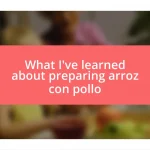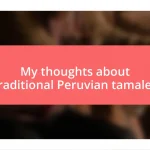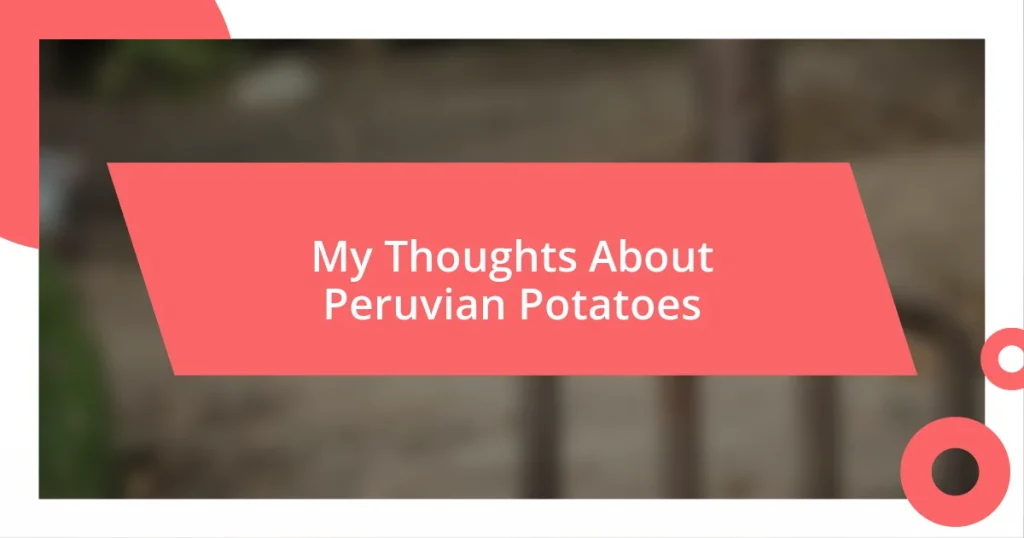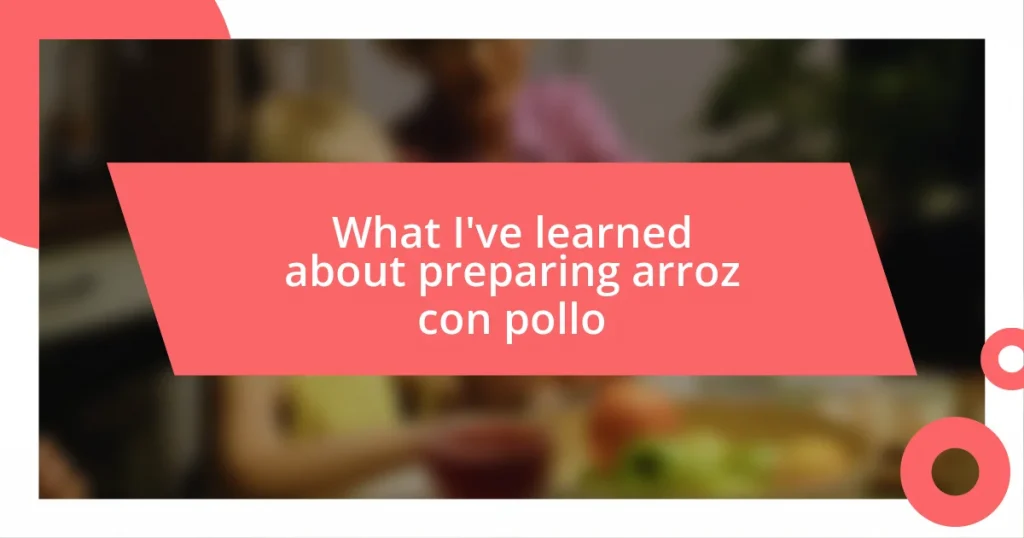Key takeaways:
- Peru is home to over 3,000 potato varieties, each reflecting a rich cultural heritage and diverse flavors.
- Peruvian potatoes are nutritionally beneficial, offering complex carbohydrates, fiber, and essential vitamins, while having a lower glycemic index compared to other potatoes.
- The cultural significance of Peruvian potatoes is profound, serving as symbols of community, tradition, and identity within culinary practices and celebrations.
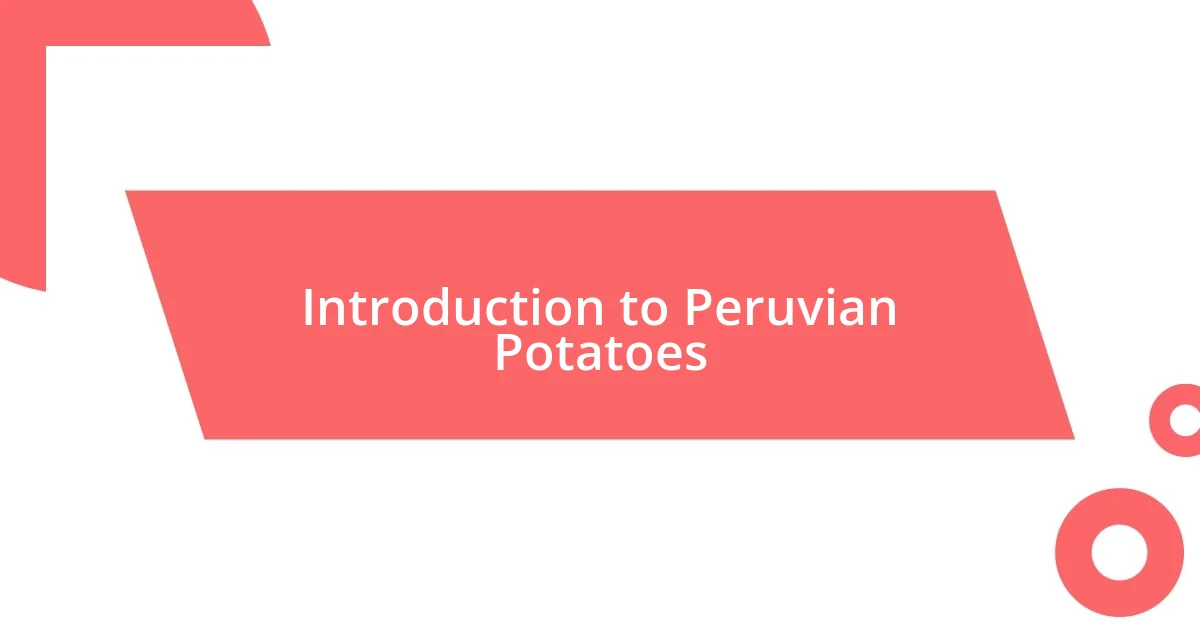
Introduction to Peruvian Potatoes
When I first encountered Peruvian potatoes, I was captivated by their incredible diversity. Did you know that Peru is home to over 3,000 different varieties? That blew my mind! Each one boasts unique colors, textures, and flavors, showcasing a cultural heritage that spans thousands of years.
As I explored these varieties, I couldn’t help but reflect on how integral potatoes are to Peruvian identity. Imagine sitting at a family table, surrounded by dishes that highlight the humble potato in ways you’ve never seen before. That’s the magic of Peruvian cuisine! It’s much more than nourishment; it’s an expression of tradition, history, and community.
The rich history of these potatoes, cultivated by the Incas and revered in ceremonies, adds another layer to their appeal. Why do some varieties taste sweet, while others are more earthy? It’s fascinating how factors like altitude and climate shape their characteristics. Every bite tells a story, and for me, it’s a reminder of the vibrant culture that thrives in the Andean highlands.
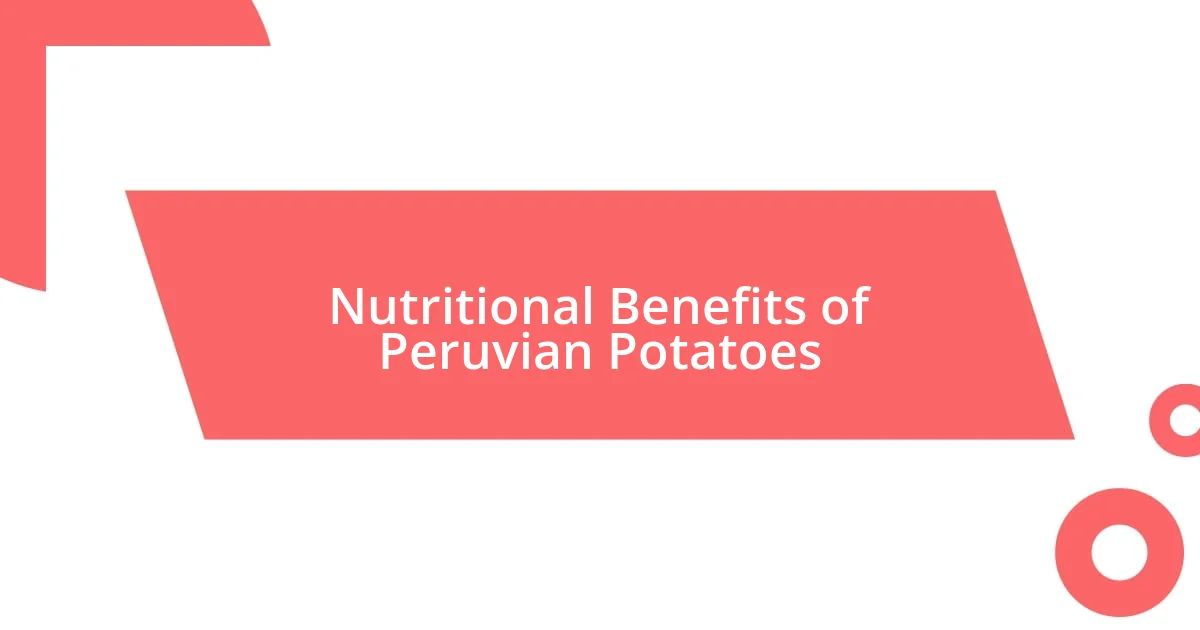
Nutritional Benefits of Peruvian Potatoes
The nutritional benefits of Peruvian potatoes are impressive and diverse. These tubers are a great source of complex carbohydrates, providing energy without the crash that comes from simple sugars. Personally, I find it eye-opening that a single serving of these potatoes can contribute to my daily fiber intake, which promotes good digestion and overall health. Have you ever noticed how satisfying a meal with these potatoes feels? It’s not just about the taste; they really do fuel the body well.
Beyond their carbohydrate content, Peruvian potatoes are packed with vitamins and minerals. They contain vitamin C, which supports the immune system, and potassium, which is crucial for heart health. I remember preparing a dish with purple potatoes, and noticing the vibrant color reflected in the bowl—it was a reminder of the antioxidants they offer, helping to fight inflammation. It’s fascinating how their variety translates into both flavor and nutritional value!
When I compare them to other common potatoes, it’s clear they stand out. Peruvian potatoes tend to have a lower glycemic index, making them a healthier choice for those watching their blood sugar levels. But it’s not just the nutritional profile that matters; it’s how they make you feel energized and satisfied, which is something I truly cherish in my meals.
| Nutritional Aspect | Peruvian Potatoes |
|---|---|
| Complex Carbohydrates | High |
| Fiber Content | Good Source |
| Vitamin C | Yes |
| Potassium | Yes |
| Glycemic Index | Lower |
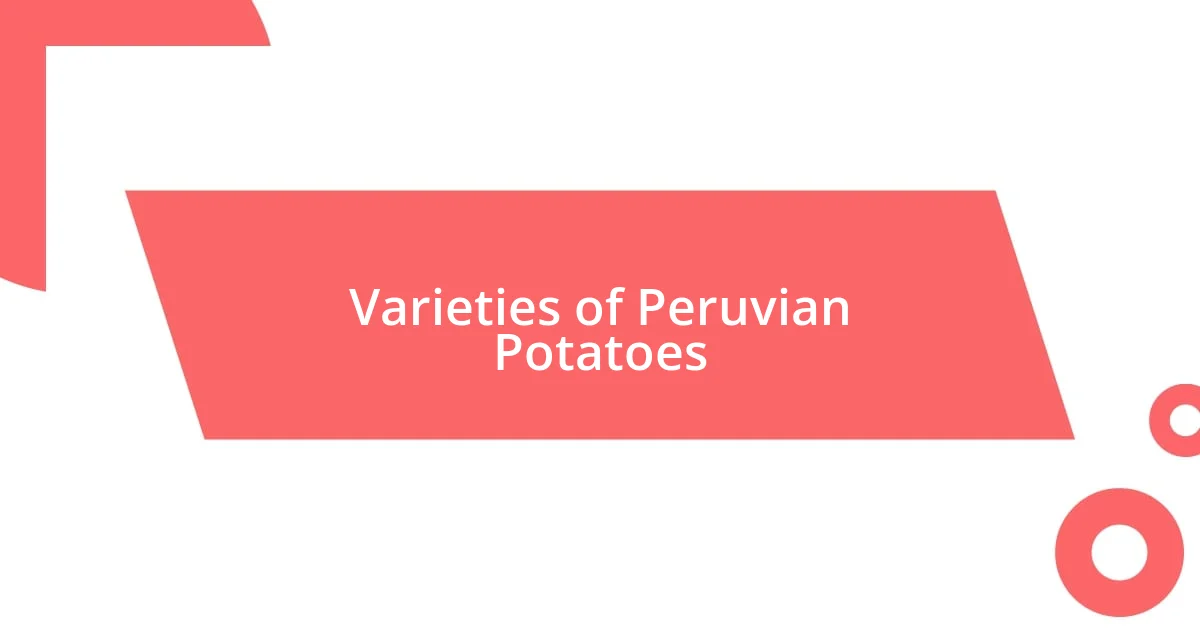
Varieties of Peruvian Potatoes
When it comes to the sheer variety of Peruvian potatoes, the selection is astounding and truly delightful. I remember stumbling upon the Yucan variety during my first visit to a local market, with its creamy texture and subtle sweetness. Each variety seems to have its own personality, making it a joy to experiment in the kitchen. Here are a few noteworthy types I’ve encountered:
- Chuno: Freeze-dried potatoes that boast a unique chewy texture.
- Papa Amarilla: A golden potato with a creamy, buttery taste that’s perfect for mashing.
- Olluco: A vibrant, colorful potato often used in traditional stews.
- Papa Huayro: Known for its nutty flavor and fine, fluffy texture, ideal for frying.
Tasting the different varieties is like going on a culinary adventure. Each time I prepare a dish, I’m reminded how these potatoes can evoke memories of meals shared with friends and family. The vibrant hues of the purple potatoes, in particular, never fail to catch my eye and spark joy. I recall a dinner party where I roasted them alongside rosemary and garlic; the aroma filled the kitchen and set the stage for a night of laughter and nostalgia. It’s incredible how food can weave together our experiences, don’t you think?
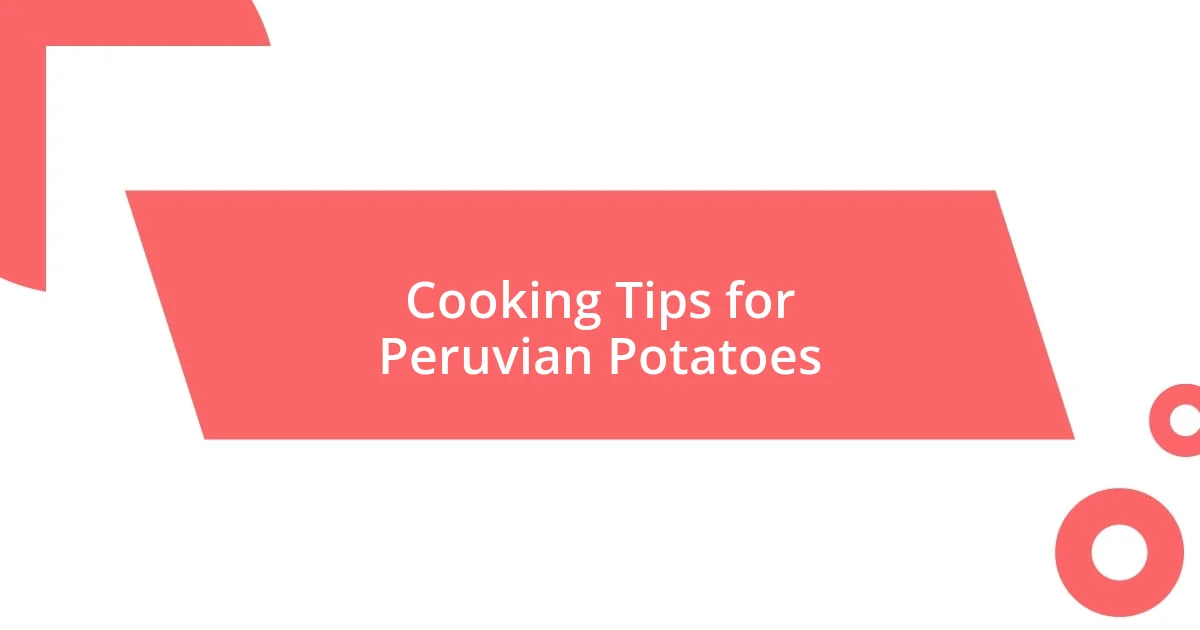
Cooking Tips for Peruvian Potatoes
Cooking Peruvian potatoes can be a delightful experience, enhancing both flavor and nutrition in your meals. One tip I’ve found particularly useful is to embrace their unique textures—experimenting with varying cooking methods really brings out their natural flavors. For example, I once roasted some purple potatoes with thyme and olive oil, and the result was a crispy exterior with a wonderfully fluffy inside. Have you ever tried roasting them? It elevates the flavor profile to a whole new level!
Another thing to consider is seasoning. Given their naturally earthy taste, I recommended pairing these potatoes with bold spices. While preparing a traditional Peruvian dish, I used a blend of cumin and smoked paprika, and it transformed the dish completely. The spices danced together in a way that complemented the potato’s flavor without overpowering it. It’s amazing how a simple addition can unlock a whole world of taste, isn’t it?
Lastly, don’t shy away from showcasing the diverse varieties you can find. I love using a mix in dishes—a rainbow of colors and textures that makes the plate not only appealing but also nutritious. When I created a potato salad loaded with different types, it became a real conversation starter at my last family gathering. The vibrant colors just drew everyone in, and sharing their unique flavors kept the buzz going throughout the meal. Isn’t it wonderful how food can spark connections and memories?
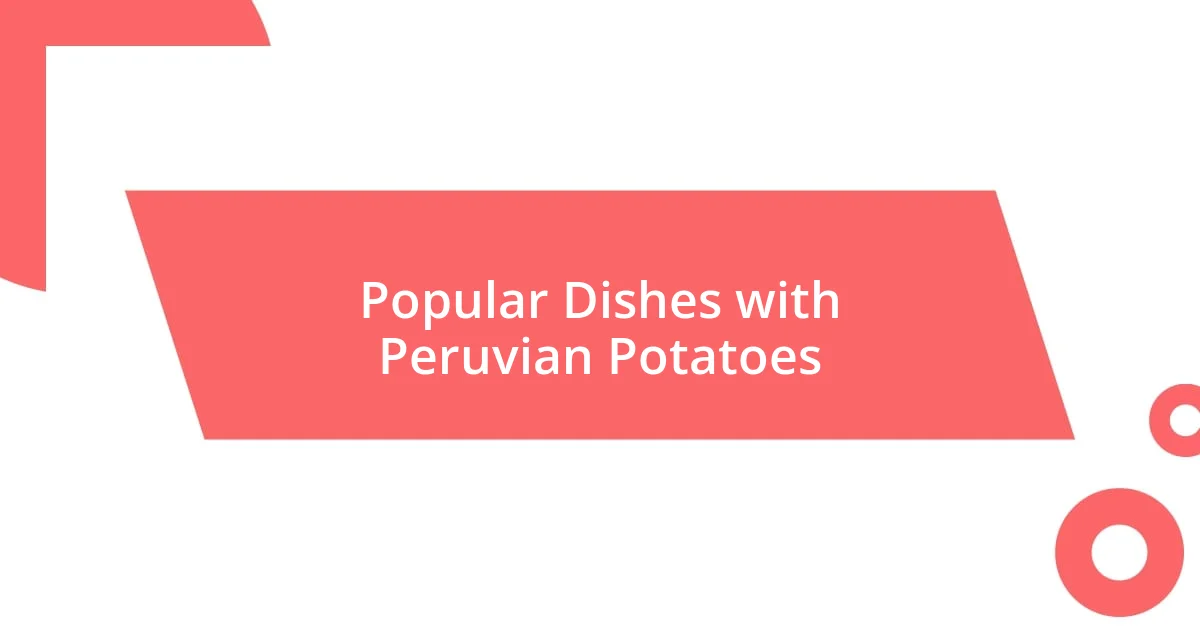
Popular Dishes with Peruvian Potatoes
When I think of popular Peruvian dishes, causa always comes to mind. It’s such a refreshing dish made with mashed yellow potatoes mixed with lime and aji amarillo, a spicy pepper that adds just the right kick. I remember trying it for the first time at a small family-run restaurant in Lima, and the way the flavors intertwined felt like a warm hug on a plate. Have you ever had a dish that made you feel so connected to a culture?
Another delightful experience I had was with papa a la huancaína, a quintessential Peruvian appetizer that features boiled potatoes slathered in a creamy, spicy cheese sauce. I enjoyed this dish during a celebration with friends, and the rich flavors were simply unforgettable. Each bite was a wonderful balance of creaminess and spice, and it amazed me how the humble potato could elevate a gathering. It’s moments like these that remind me how food brings people together, isn’t that true?
Lastly, there’s the traditional ocopa, a dish that combines boiled potatoes with a rich sauce made from toasted peanuts, yellow pepper, and herbs. The first time I tried this at a local festival, the explosion of flavors felt transformative. The smooth, nutty sauce perfectly complemented the fluffy potatoes, creating a blissful harmony. I find that cooking this dish always sparks some amusing kitchen memories—like the time I accidentally spilled a bit too much aji! Have you ever had a cooking mishap that turned into a funny story?
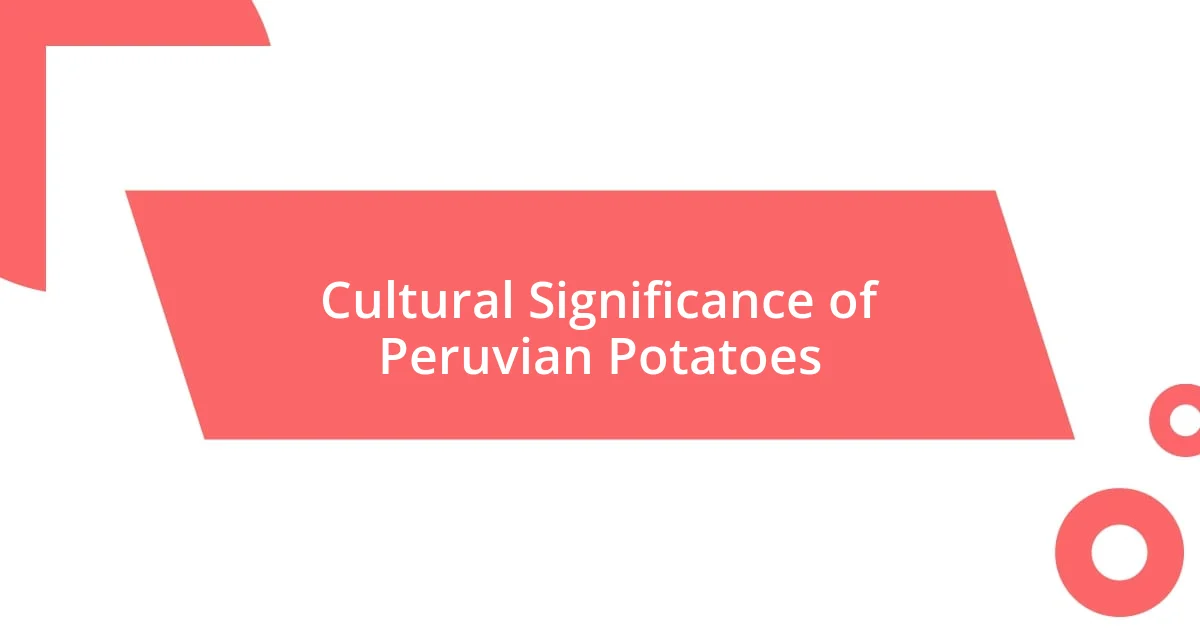
Cultural Significance of Peruvian Potatoes
The cultural significance of Peruvian potatoes goes beyond their culinary uses; they are deeply woven into the fabric of Peruvian identity. I remember visiting a rural village where the locals proudly taught me about the different types of potatoes they grew. Each variety had its own story, linked to the land, tradition, and their ancestors. Isn’t it fascinating how food can serve as a living testament to a culture’s history?
Moreover, these potatoes play an essential role in celebrations and rituals. In many communities, they are part of traditional festivals, symbolizing abundance and connection with the earth. I’ll never forget attending a harvest festival, where families shared colorful dishes made from a variety of potatoes. It felt uplifting to witness how this simple tuber brought everyone together, reinforcing the bonds of community. Have you ever felt the warmth of togetherness over a shared dish?
Peruvian potatoes have also adapted admirably to different cooking methods and regional flavors, signifying how culture evolves while respecting its roots. I often find joy in exploring dishes from various regions, realizing each preparation reflects local customs. One time, I tried a spicy potato stew in Arequipa, and it struck me how regional differences highlight the creativity and resilience of Peruvian people. Isn’t it impressive how a single ingredient can embody such richness and diversity?
